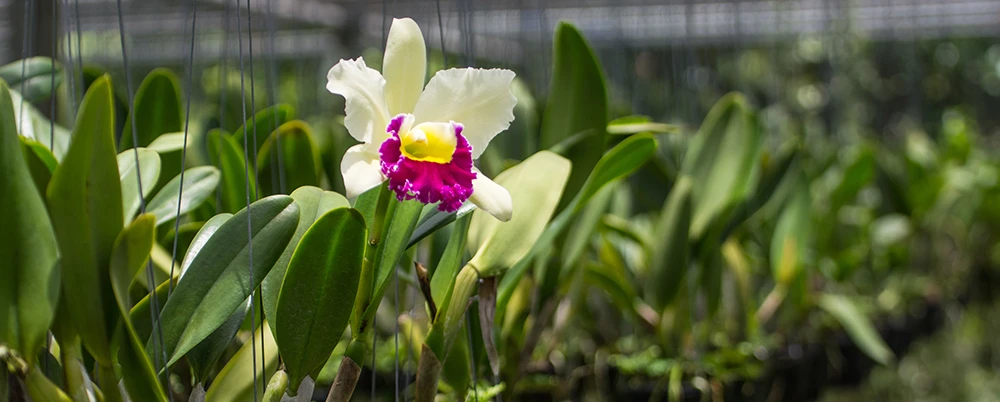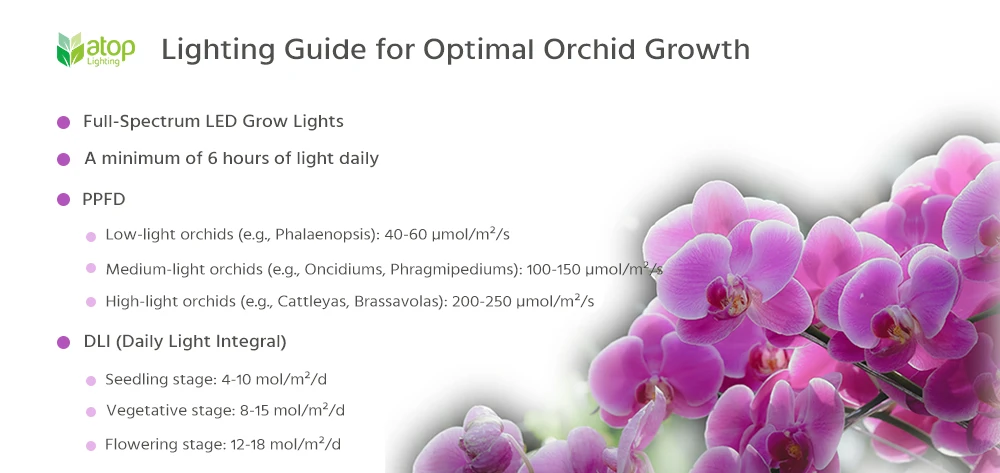How to Grow Orchids Successfully with LED Grow Lights
With their delicate beauty and a wide variety of species, orchids have long been cherished by both home gardeners and commercial growers. These stunning flowers come in a vibrant range of colors and can last from six to ten weeks on the plant. However, growing orchids indoors can be tricky, especially when it comes to providing the right light. Fortunately, advancements in LED technology have made it easier to cultivate orchids indoors and enjoy their blooms year-round.
Popular orchids like Phalaenopsis and Paphiopedilum thrive under LED grow lights, which offer an ideal balance of intensity and spectrum. In this blog, we'll explore how to grow orchids using LED grow lights, ensuring your plants receive the optimal conditions for success.

Why LED Grow Lights?
The advantages of LED grow lights make them excellent choices for orchid cultivation, especially for commercial growers looking to optimize their operations, increase yield, and produce high-quality blooms consistently.
- LED lights produce less heat, which can reduce the risk of overheating and damaging the delicate leaves and flowers of orchids.
- LED grow lights can be customized to emit different wavelengths of light, allowing you to provide the exact light spectrum that promotes healthier and more vibrant orchid growth.
- LED grow lights consume far less energy compared to traditional grow lights like fluorescent or incandescent bulbs, resulting in lower electricity bills.
- LED grow lights last much longer than traditional grow lights, reducing the need for frequent replacements and lowering maintenance costs over time.
Lighting Guide for Optimal Orchid Growth
Providing the right lighting is essential for healthy orchid growth and abundant flower production. In their natural habitats, most orchids thrive in bright environments. When growing orchids indoors, the lighting requirements vary depending on the species and location.
Use Full-Spectrum LED Grow Lights
Full-spectrum LED grow lights are ideal for orchids, as they closely mimic natural sunlight and support all stages of the plant's growth—from germination to flowering. If you have specific growing goals, consider a customized light spectrum. As a leading horticultural lighting manufacturer, Atop Lighting is well-equipped to help you find the right solution.
Ensure Adequate Lighting Duration
Orchids generally need a minimum of 6 hours of light daily, with some species requiring up to 12 hours. Adjust the duration based on the needs of your orchids.
Adjust Light Intensity Based on Orchid Type and Growth Stage
Light intensity is the most complex aspect of orchid lighting. It varies by species, growth stage, and location. Orchids typically require toplighting with light levels ranging from 40 to 300 µmol/m²/s, depending on the type:
- Low-light orchids (e.g., Phalaenopsis) need a PPFD of 40-60 µmol/m²/s.
- Medium-light orchids (e.g., Oncidiums, Phragmipediums) require 100-150 µmol/m²/s.
- High-light orchids (e.g., Cattleyas, Brassavolas) thrive with 200-250 µmol/m²/s.
Consider DLI (Daily Light Integral)
Since day length and solar energy vary by season and location, DLI is an important measure for evaluating the total amount of light your orchids receive each day. DLI is expressed in mol/m²/d, with different stages of growth requiring different levels:
- Seedling stage: 4-10 mol/m²/d
- Vegetative stage: 8-15 mol/m²/d
- Flowering stage: 12-18 mol/m²/d

How to Care Orchid Plants
Like all plants, orchids need the right balance of light, temperature, humidity, water, and nutrients to thrive.
Watering: Water your orchids when the potting medium is nearly dry. Keep the soil consistently moist, but avoid overwatering, as this can cause root rot.
Temperature: Most orchids prefer temperatures between 65-85°F (18-30°C). Some species may require cooler nights to initiate blooming. Avoid sudden temperature fluctuations, or it will stress plants.
Humidity: Orchids prefer a humidity level of 50%-70%. You can maintain this by misting the plant regularly, using humidity trays, or running a room humidifier if necessary.
Potting mix: Use a well-draining orchid-specific potting mix that contains bark and peat moss. This allows for good airflow around their roots. Many orchids prefer to be slightly pot-bound, so don’t use oversized containers.
Fertilizing: During the growing season, feed your orchids regularly with a balanced, water-soluble fertilizer diluted to one-quarter strength. Reduce or stop fertilizing during dormancy.
Pests and diseases: Regularly inspect your orchids for signs of pests like mealybugs or scale insects. Prevent diseases by ensuring proper air circulation and avoiding overwatering.
How to Tell if Orchids Have the Right Light
Orchids give clear signs when they're not receiving the right amount of light. Understanding these signs can help you make necessary adjustments. Keep in mind that lighting works together with other factors like watering, temperature, and humidity. Balancing all these elements is key to healthy orchids.
Signs of Insufficient Light
When orchids don’t get enough light, they may show the following symptoms:
- Dark green leaves
- Elongated or leggy growth
- Failure to bloom
- Slow growth
Solutions:
- Increase light intensity by placing the orchids closer to the light source or by adding supplemental LED grow lights.
- Check for any obstructions that might be blocking the light and remove them to ensure the plants can fully absorb the available light.
Signs of Excessive Light
Too much light can cause:
- Yellowing or bleached leaves
- Sunburn spots
- Browning at the edges of leaves
- Wilting despite adequate watering
Solutions:
- Reduce light intensity by raising LED grow lights higher or lowering their brightness.
- Decrease the daily exposure time to light, either by reducing the duration of natural light or adjusting the timer on LED grow lights.
Inconsistent Lighting Issues
Inconsistent lighting can lead to:
- Uneven growth
- Leaning or stretching toward the light source
- Irregular flowering across plants
Solutions:
- Ensure even light distribution by using reflective materials to bounce light evenly around the plant.
- Adjust the position of LED lights to provide more uniform coverage.
- Use timers for LED grow lights to maintain consistent daily light exposure.
Light-Related Heat Issues
Excessive heat from grow lights can cause:
- Leaf tips to turn brown
- Rapid moisture loss in the growing medium
- Root damage
Solutions:
- Ensure proper ventilation around the plants.
- Increase air circulation with fans.
- Maintain a safe distance between the plants and the light source to avoid overheating.

